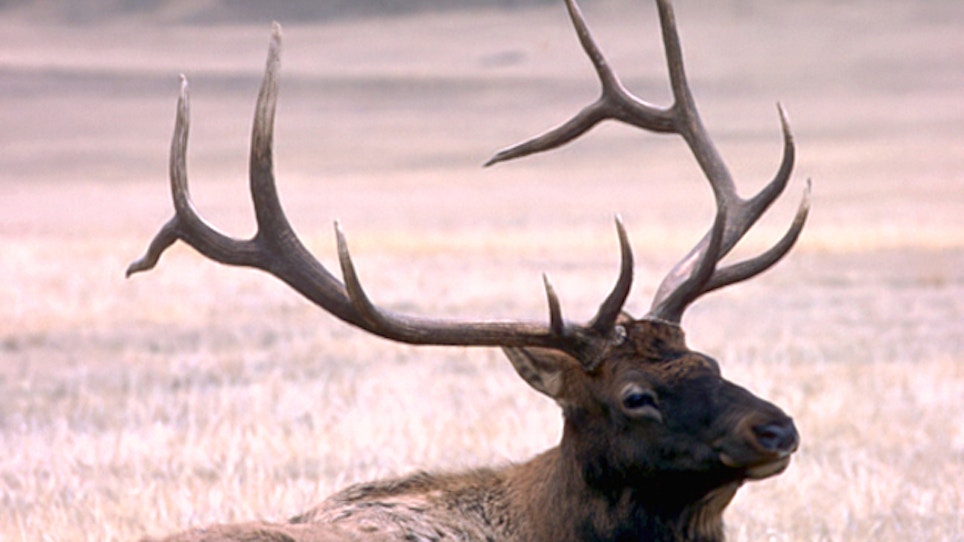By NICOLE KLAUSS | Daily Record
ELLENSBURG, Wash. (AP) — About 500 elk surrounded a Washington Department of Fish and Wildlife truck at Joe Watt Canyon on Thursday morning as they waited for their daily hay.
For more than four decades, elk have been coming to the Joe Watt and Robinson canyons during the winter months to eat the alfalfa hay put out in the mornings by the department.
The feed stations typically start in December when accumulated snowfall makes it hard for elk to find food to get through winter, but the program didn't start until February this year.
"It's been slow for the elk to come in because the weather really didn't materialize in a hurry," said Craig Schnebly, the Rocky Mountain elk ranger for the department. "We started getting snow three weeks ago and the elk started piling in."
Schnebly has been feeding the L.T. Murray elk herd each winter for 27 years. He is familiar with many of the bull elk and has names for some of the more identifiable ones like Webster, a bull that Schnebly guessed is between 13 to 15 years old.
The feed station program started in the mid-1960s after the department built a fence to separate the elk from the Interstate 90, farms and orchards. It was sporadic for a few years until the 1970s when it became a regular winter WDFW activity.
The purpose is to keep wintering elk from migrating to lower elevation areas of Kittitas Valley where farmers and ranchers live.
"If they did, they'd wind up in farmers' fields and hay barns, and it would be a complete disaster for the wildlife, too," Schnebly said.
This winter has not been a peak year in terms of the number of elk attending the feedings.
Schnebly said he's seen about 700 heads in each canyon, and daily feeding totals have ranged from 400 to 700.
In years with more snow, more elk come down to feed.
"We've had close to 1,000 head in each lot pretty consistently for the last few years," Schnebly said. "We've come close to 2,000, but we've never hit 2,000."
The L.T. Murray herd is counted as part of a larger Yakima herd, which totals just under 12,000 elk.
With fewer elk coming down from the hills to eat, the department is not having to put out as much hay, which means WDFW is saving money.
"If we'd have gotten snow like we normally do, it would have been a long season," Schnebly said. "It's going to be a short season. We're saving some hay. We're saving some dollars here."
Feeding the elk is a two-man job.
Schnebly and Kyle Hill, a natural resource technician with WDFW, use a tractor to load a truck with four bales of hay, each weighing about 1,300 pounds. They drive the truck out to the field and let the elk line up around it. Then one of them stands on the back of the truck, breaks up the hay, and throws it onto clean ground while the other drives the truck down the field. Using this method, they make several long lines of hay for the elk to gather around.
"We'll put out about seven pounds per animal," Schnebly said. "It depends on the quality of hay."
They do the same at Robinson Canyon, about four miles south of Joe Watt Canyon. The number of bales is adjusted accordingly, depending on how many elk show up.
This is the first winter Hill has worked on the elk wintering program.
"It's been really neat to see the animals, and see the way they get used to the truck, how they kind of habituate to Craig and I in the truck a little bit and get to know their feed," he said. "We can tell if they've been spooked somehow. They won't come to us."
There is no set date for when the feeding season ends, but workers know it's time when the elk stop showing up.
"The elk will tell you when it's time to go," Schnebly said. "They'll eat green grass before they eat the dry hay."
With fewer elk, fewer visitors have come to watch this year. On Thursday, one lone truck parked outside the Joe Watt Canyon gate to watch the elk feeding.
The Robinson Canyon feed site is not open to the public.
"It's been tough because the elk are hit and miss," said Shana Winegeart, manager of the department's L.T. Murray Wildlife Area. "The weather is hit and miss. In a normal year we'd have 10 cars out there. We may only have one or two (now)."
Winegeart has led several presentations for the Boy Scouts and children from Central Washington University's child care center, but some elementary school classes didn't make it out this year.
Another reason people traditionally head out to the area is to take advantage of the nearby hill that is usually covered with snow.
"A lot of people bring their kids out to sled on the hill, and then see the elk at the same time," Schnebly said. "That wasn't a big draw this year."
———
Information from: Daily Record, www.kvnews.com






